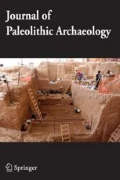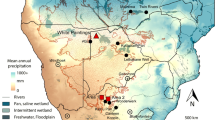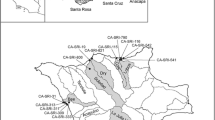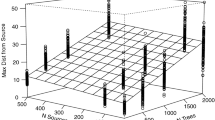Abstract
Excavations at Aghitu-3 Cave in Armenia revealed stratified Upper Palaeolithic archaeological horizons (AHs), spanning from 39 to 36,000 cal BP (AH VII) to 29–24,000 cal BP (AH III) and from which we identified the sources of 1120 obsidian artifacts. Not only does AH III—deposited at the onset of the Last Glacial Maximum—have the most artifacts from non-regional sources but also the artifacts originate from the greatest variety of sources, including two ≥ 270 km on foot in different directions. The amount of retouch and density of lithics—as expressed by whole assemblage behavioral indicators (WABI)—suggest a trend from more expediency to more curation between the deposition of AHs VII and IV. This was followed by a substantial shift back to expediency during the deposition of AH III, corresponding to greater logistical mobility. Here, we use agent-based modeling (ABM) to interpret these data. Greater interactions between foraging groups are not an unavoidable outcome of a shift from residential to logistical mobility. Some variables (i.e., lithic stock, use intensity, provisioning strategy) can be ruled out, while other variables (i.e., decreased source abundance, a shift to direct procurement) appear inconsistent with the archaeological data. Territory spacing, in contrast, has a clear and predictable effect. A small decrease in territory spacing can yield notable increases in inter-group contact opportunities and can be explained by an increase in population densities as the climate cooled. Following this scenario, we assume that, as AH III accumulated, the cave’s occupants not only moved farther distances but also more frequently encountered neighboring groups.

















Similar content being viewed by others
References
Andrefsky, W., Jr. (1998). Lithics: macroscopic approaches to analysis. Cambridge Manuals in Archaeology: Cambridge University Press.
Arakawa, F. 2006. Lithic raw material procurement and the social landscape in the Central Mesa Verde Region, A.D. 600-1300. Doctoral Dissertation, Department of Anthropology, Washington State University.
Axtell, R. L., Epstein, J. M., Dean, J. S., Gumerman, G. J., Swedlund, A. C., Harburger, J., Chakravarty, S., Hammond, R., & Parker, M. (2002). Population growth and collapse in a multiagent model of the Kayenta Anasazi in Long House Valley. Proceedings of the National Academy of Sciences, 99, 7275–7279.
Banks, W. E., D’Errico, F., Peterson, A. T., Vanhaeren, M., Kageyama, M., Sepulchre, P., Ramstein, G., Jost, A., & Lunt, D. (2008). Human ecological niches and ranges during the LGM in Europe derived from an application of eco-cultural niche modeling. Journal of Archaeological Science, 35(2), 481–491.
Barceló, J. A., del Castillo Bernal, F., del Olmo, R., Mameli, L., Quesada, F. J. M., Poza, D., & Vilà, X. (2014). Social interaction in hunter-gatherer societies: simulating the consequences of cooperation and social aggregation. Social Science Computer Review, 32(3), 417–436.
Barceló, J. A., del Castillo Bernal, F., del Olmo, R., Mameli, L., Quesada, F. J. M., Poza, D., & Vilà, X. (2015). Simulating Patagonian territoriality in prehistory: space, frontiers and networks among hunter-gatherers. In G. Wurzer, K. Kowarik, & H. Reschreiter (Eds.), Agent-based modeling and simulation in archaeology (pp. 217–256). Springer.
Barton, C. M. (1991). Retouched tools, fact or fiction? Paradigms for interpreting Paleolithic chipped stone. In G. A. Clark (Ed.), Perspectives on the past (pp. 143–163). University of Pennsylvania Press.
Barton, C. M. (1998). Looking back from the world's end: paleolithic settlement and mobility at Gibraltar. In J. L. Sanchidrián & S. Vallejo (Eds.), Las Culturas del Pleistoceno Superior en Andalucía (pp. 13–23). Patronato de la Cueva de Nerja.
Barton, C.M., Riel-Salvatore, J. 2013. Formation of lithic assemblages V. 1 Arizona State University, CoMSES Computational Model Library.
Barton, C. M., & Riel-Salvatore, J. (2014). The formation of lithic assemblages. Journal of Archaeological Science, 46, 334–352.
Barton, C. M., Riel-Salvatore, J., Anderies, J. M., & Popescu, G. (2011). Modeling human ecodynamics and biocultural interactions in the Late Pleistocene of Western Eurasia. Human Ecology, 39, 705–725.
Barton, C. M., Ullah, I. I. T., Bergin, S. M., Mitasova, H., & Sarjoughian, H. (2012). Looking for the future in the past: long-term change in socioecological systems. Ecological Modelling, 241, 42–53.
Barton, C. M., Villaverde, V., Zilhão, J., Aura, J. E., Garcia, O., & Badal, E. (2013). In glacial environments beyond glacial terrains: human eco-dynamics in late Pleistocene Mediterranean Iberia. Quaternary International, 318, 53–68.
Bar-Yosef, O. (1994). The contribution of Southwest Asia to the study of modern human origins. In M. H. Nitecki & D. V. Nitecki (Eds.), Origins of anatomically modern humans (pp. 23–66). Plenum Press.
Berger, A., & Loutre, M.-F. (1991). Insolation values for the climate of the last 10 million of years. Quaternary Science Reviews, 10(4), 297–317.
Berger, A., & Loutre, M.-F. (1999). Parameters of the Earth’s orbit for the last 5 million years in 1 kyr resolution. PANGAEA. https://doi.org/10.1594/PANGAEA.56040.
Binford, L. R. (1979). Organization and formation processes: looking at curated technologies. Journal of Anthropological Research, 35, 255–273.
Binford, L. R. (1980). Willow smoke and dogs’ tails: hunter-gatherer settlement systems and archaeological site formation. American Antiquity, 45, 4–20.
Binford, L. R. (1981). Bones: ancient men and modern myths. Academic Press.
Binford, L. R., & Binford, S. R. (1966). A preliminary analysis of functional variability in the Mousterian of Levallois facies. American Anthropologist, 68, 238–295.
Bordes, F. (1961). Typologie du Paléolithique Inferieur et Moyen. Paris: Editions CNRS.
Brantingham, P. J. (2003). A neutral model of stone raw material procurement. American Antiquity, 68, 487–509.
Brantingham, P. J. (2006). Measuring forager mobility. Current Anthropology, 47(3), 435–459.
Christiansen, J.H., Altaweel, M.R. 2006. Understanding ancient societies: a new approach using agent-based holistic modeling. Structure and Dynamics: eJournal of Anthropological and Related Sciences 1(2), article 7.
Clark, A.E. 2008. Changes in occupation intensity during the Lower and Middle Paleolithic at Tabun Cave, Israel. Master’s thesis, University of Arizona, Tucson.
Clark, G. A., & Barton, C. M. (2017). Lithics, landscapes & la Longue-durée—curation & expediency as expressions of forager mobility. Quaternary International, 450, 137–149.
Clark, P. U., Dyke, A. S., Shakun, J. D., Carlson, A. E., Clark, J., Wohlfarth, B., Mitrovica, J. X., Hostetler, S. W., & McCabe, A. M. (2009). The last glacial maximum. Science, 325(5941), 710–714.
Close, A. E. (2000). Reconstructing movement in prehistory. Journal of Archaeological Method and Theory, 7, 49–77.
Danielisová, A., Olševičová, K., Cimler, R. Machálek, T. 2015. Understanding the Iron Age economy: sustainability of agricultural practices under stable population growth. In: Wurzer, G., Kowarik, K., Reschreiter, H. (eds.), Agent-based modeling and simulation in archaeology, pp. 183–216. Springer.
Dean, J. S., Gummerman, G. J., Epstein, J. M., Axtell, R. L., Swedlund, A. C., Parker, M. T., & McCarroll, S. (1999). Understanding Anasazi culture change through agent-based modeling. In T. Kohler & G. J. Gummerman (Eds.), Dynamics in human and primate societies (pp. 179–206). Oxford University Press.
Dennell, R. W., Martinón-Torres, M., & Bermúdez de Castro, J. M. (2011). Hominin variability, climatic instability and population demography in Middle Pleistocene Europe. Quaternary Science Reviews, 30, 1511–1524.
Dibble, H. (1984). Interpreting typological variation of Middle Paleolithic scrapers: function, style or sequence of reduction? Journal of Field Archaeology, 11, 431–436.
Dibble, H. (1995). Middle Paleolithic scraper reduction: background, clarification, and review of the literature to date. Journal of Archaeological Method and Theory, 2, 299–368.
Dibble, H., Schurmans, U. A., Iovita, R. P., & McLaughlin, M. V. (2005). The measurement and interpretation of cortex in lithic assemblages. American Antiquity, 70(3), 545–560.
EPICA community members. (2004). Eight glacial cycles from an Antarctic ice core. Nature, 429, 623–628.
Epstein, J. M., & Axtell, R. (1996). Growing artificial societies: social science from the bottom-op. The Brookings Institution Press and MIT Press.
Finlayson, J. C. (2004). Neanderthals and modern humans: an ecological and evolutionary perspective. Cambridge University Press.
Fitzhugh, B. (2002). Residential and logistical strategies in the evolution of complex hunter-gatherers on the Kodiak Archipelago. In B. Fitzhugh & J. Habu (Eds.), Beyond foragers and collectors: evolutionary change in hunter-gatherer settlement systems (pp. 257–306). Kluwer-Plenum.
Frahm, E. (2012). Distinguishing Nemrut Dağ and Bingöl A obsidians: geochemical and landscape differences and the archaeological implications. Journal of Archaeological Science, 39, 1435–1444.
Frahm, E. (2016). Can I get chips with that? Obsidian sourcing down to the microdebitage with portable XRF. Journal of Archaeological Science: Reports, 9, 448–467.
Frahm, E., & Hauck, T. C. (2017). Origin of an obsidian scraper at Yabroud Rockshelter II (Syria): implications for Near Eastern social networks in the early Upper Palaeolithic. Journal of Archaeological Science: Reports, 13, 415–427.
Frahm, E., Feinberg, J. M., Schmidt-Magee, B., Wilkinson, K. N., Gasparyan, B., Yeritsyan, B., & Adler, D. S. (2016). Middle Palaeolithic lithic procurement behaviors at Lusakert Cave 1, Hrazdan Valley, Armenia. Journal of Human Evolution, 91, 73–92.
Galbreath, K. E., Hafner, D. J., & Zamudio, K. R. (2009). When cold is better: climate-driven elevation shifts yield complex patterns of diversification and demography in an alpine specialist (American pika, Ochotona princeps). Evolution, 63, 2848–2863.
Gamble, C. (1996). Making tracks: hominid networks and the evolution of the social landscape. In J. Steele & S. Shennen (Eds.), The archaeology of human ancestry, pp. 253–278. Routledge Chapman & Hall.
Gasparyan, B., Kandel, A. W., & Montoya, C. (2014). Living the high life: the Upper Paleolithic settlement of the Armenian highlands. In B. Gasparyan & M. Arimura (Eds.), Stone Age of Armenia: a guide-book to the Stone Age archaeology in the Republic of Armenia (Center for Cultural Resource Studies) (pp. 107–131). Kanazawa: Kanazawa University.
Gilbert, N. (2008). Agent-based models. In Quantitative applications in the social sciences (p. 153). Sage Publishing.
Gilbert, N., & Troitzsch, K. G. (2009). Simulation for the social scientist. Open University Press.
Griffan, A. F., & Stanish, C. (2007). An agent-based model of prehistoric settlement patterns and political consolidation in the Lake Titicaca Basin of Peru and Bolivia. Stucture and Dynamics, 2(2).
Grove, M. (2009). Hunter-gatherer movement patterns: causes and constraints. Journal of Anthropological Archaeology, 28, 222–233.
Harte, J. (1988). Consider a spherical cow: a course in environmental problem solving. University Science Books.
Hays, J. D., Imbrie, J., & Shackleton, N. J. (1976). Variations in the Earth's orbit: pacemaker of the Ice Ages. Science, 194(4270), 1121–1132.
Hess, S.C. 1997. Rocks, range, and Renfrew: using distance-decay effects to study late Pre-Mazama Period obsidian acquisition and mobility in Oregon and Washington. Doctoral dissertation, Department of Anthropology, Washington State University, Pullman.
Hodder, I. (1977). The distribution of material culture items in the Baringo District, Western Kenya. Man, New Series, 12(2), 239–269.
Indermühle, A., Monnin, E., Stauffer, B., Stocker, T. F., & Wahlen, M. (2000). Atmospheric CO2 concentration from 60 to 20 kyr BP from the Taylor Dome ice cores, Antarctica. Geophysical Research Letters, 27(5), 735–738.
Janssen, M. A. (2009). Understanding artificial Anasazi. Journal of Artificial Societies and Social Simulation, 12(4), 13.
Janssen, M. A., Sept, J. M., & Griffith, C. S. (2007). Hominids foraging in a complex landscape: could Homo ergaster and Australopithecus boisei meet their calories requirements? In S. Takahashi, D. Salach, & J. Rouchier (Eds.), Advancing social simulation: the first world congress (pp. 307–318). Japan: Springer.
Kandel, A. W., Gasparyan, B., Allué, E., Bigga, G., Bruch, A., Cullen, V. L., Frahm, E., Ghukasyan, R., Gruwier, B., Jabbour, F., Miller, C. E., Taller, A., Vardazaryan, V., Vasilyan, D., & Weissbrod, L. (2017). The earliest evidence for Upper Paleolithic occupation in the Armenian Highlands at Aghitu-3 Cave. Journal of Human Evolution, 110, 37–68.
Kelly, R. L. (1983). Hunter-gatherer mobility strategies. Journal of Anthropological Research, 39, 277–306.
Kelly, R. L. (1992). Mobility sedentism: concepts, archaeological measures, and effects. Annual Review of Anthropology, 21, 43–66.
Kowarik, K., Reschreiter, H., Wurzer, G. 2015. Mining with agents: modelling prehistoric mining and prehistoric economy. In: Wurzer, G., Kowarik, K., Reschreiter, H. (eds.), Agent-based modeling and simulation in archaeology, pp. 141–159. Springer.
Kuhn, S. (1991). Unpacking reduction: lithic raw-material economy in the Mousterian of west-central Italy. Journal of Anthropological Archaeology, 10, 76–106.
Kuhn, S. (1992). On planning and curated technologies in the Middle Paleolithic. Journal of Anthropological Research, 48, 185–214.
Kuhn, S. (1994). A formal approach to the design and assembly of mobile toolkits. American Antiquity, 59, 426–442.
Kuhn, S. (1995). Mousterian technology—an ecological perspective. Princeton University Press.
Kuhn, S. (2004). Upper Paleolithic raw material economies at Üçağızlı cave, Turkey. Journal of Anthropological Archaeology, 23(4), 431–448.
Kuhn, S., & Stiner, M. C. (2007). Body ornamentation as information technology: towards an understanding of the significance of early beads. In P. Mellars, K. Boyle, O. Bar-Yosef, & C. Stringer (Eds.), Rethinking the human revolution: new behavioural and biological perspectives on the origin and dispersal of modern humans. McDonald Institute for Archaeological Research University of Cambridge.
Liao, T.F. 2008. Series editor’s introduction. In: N. Gilbert, Agent-based models. Quantitative applications in the social sciences 153. Pp. IX-X.
Mellars, P. (1996). The Neanderthal legacy. Princeton University Press.
Miller, A., & Barton, C. M. (2008). Exploring the land: a comparison of land-use patterns in the Middle and Upper Paleolithic of the western Mediterranean. Journal of Archaeological Science, 35, 1427–1437.
Molyneaux, B. L. (2002). Exploring the landscapes of long-distance exchange: evidence from Obsidian Cliffs and Devils Tower, Wyoming. In M. D. Glascock (Ed.), Geochemical evidence for long-distance exchange (pp. 133–152). Westport: Bergin and Garvey.
Montoya, C., Balasescu, A., Joannin, S., Ollivier, V., Liagre, J., Nahapetyan, S., Ghukasyan, R., Colonge, D., Gasparyan, B., & Chataigner, C. (2013). The Upper Palaeolithic site of Kalavan 1 (Armenia): an Epigravettian settlement in the Lesser Caucasus. Journal of Human Evolution, 65, 621–640.
Nelson, M. (1991). The study of technological organization. Archaeological Method and Theory, 3, 57–100.
Parry, W. J., & Kelly, R. L. (1987). Expedient core technology and sedentism. In J. K. Johnson & C. A. Morrow (Eds.), The organization of core technology. Westview Press.
Perreault, C., & Brantingham, P. J. (2011). Mobility-driven cultural transmission along the forager–collector continuum. Journal of Anthropological Archaeology, 30, 62–68.
Platt, D.E., Haber, M., Dagher-Kharrat, M.B., Douaihy, B., Khazen, G., Bonab, M.A., Salloum, A., Mouzaya, F., Luiselli, D., Tyler-Smith, C., Renfrew, C., Matisoo-Smith, E., Zalloua, P.A. 2017. Mapping post-glacial expansions: the peopling of Southwest Asia. Scientific Reports 7, Article 40338.
Powell, A., Shennan, S., & Thomas, M. (2009). Late Pleistocene demography and the appearance of modern human behavior. Science, 324, 1298–1301.
Premo, L. S. (2005). Patchines and prosociality: an agent-based model of Plio/Pleistocene hominid food sharing. In P. Davidson, K. Takadama, & B. Logan (Eds.), Multi-agent and multi-agent-based simulation (pp. 210–224). Springer-Verlag.
Premo, L. S. (2006). Agent-based models as behavioral laboratories for evolutionary anthropological research. Arizona Anthropologist, 17, 91–113.
Premo, L. S. (2012). The shift to a predominantly logistical mobility strategy can inhibit rather than enhance forager interaction. Human Ecology, 40, 647–649.
Premo, L.S. 2015. Mobility and cultural diversity in central-place foragers: implications for the emergence of modern human behavior. Society for American Archaeology 80th annual meeting, San Francisco.
Riel-Salvatore, J., & Barton, C. M. (2004). Late Pleistocene technology, economic behavior, and land-use dynamics in southern Italy. American Antiquity, 69, 257–274.
Riel-Salvatore, J., Barton, C.M. 2007. New quantitative perspectives on the Middle-Upper Paleolithic transition: the view from the northern Mediterranean. In: Riel-Salvatore, J., Clark, G.A. (eds.), Early Upper Paleolithic “transitional” industries: new questions, new methods. Oxford, pp. 61e74. British Archaeological Reports No. 1620.
Riel-Salvatore, J., Popescu, G., & Barton, C. M. (2008). Standing at the gates of Europe: human behavior and biogeography in the southern Carpathians during the late Pleistocene. Journal of Anthropological Archaeology, 27, 399–417.
Sackett, J. (1991). Straight archaeology French style: the phylogenetic paradigm in historic perspective. In G. A. Clark (Ed.), Perspectives on the past (pp. 109–140). Philadelphia: University of Pennsylvania Press.
Sandgathe, D.M., 2006. Examining the Levallois reduction strategy from a design theory point of view. Archaeopress, Oxford. British Archaeological Reports No. 1417.
Shott, M. J. (1996). An exegesis of the curation concept. Journal of Anthropological Research, 52, 259–280.
Shott, M. J., & Sillitoe, P. (2005). Use life and curation in New Guinea experimental used flakes. Journal of Archaeological Science, 32, 653–663.
Snyder, C. W. (2016). Evolution of global temperature over the past two million years. Nature, 538(7624), 226–228.
Stellman, S. D. (1973). A spherical chicken. Science, 182(4119), 1296.
Swedlund, A. C., Sattenspiel, L., Warren, A. L., & Gumerman, G. J. (2015). Modeling archaeology: origins of the artificial Anasazi project and beyond. In G. Wurzer, K. Kowarik, & H. Reschreiter (Eds.), Agent-based modeling and simulation in archaeology (pp. 37–50). Springer.
Timm, I. J., Lorig, F., Hölzchen, E., & Hertler, C. (2016). Multi-scale agent-based simulation of long-term dispersal processes: towards a sophisticated simulation model of Hominin dispersal. In J. Barceló & F. Del Castillo (Eds.), Simulating prehistoric and ancient worlds. computational social sciences (pp. 141–157). Springer.
Tornero, C., Balasse, M., Bălăşescu, A., Chataigner, C., Gasparyan, B., & Montoya, C. (2016). The altitudinal mobility of wild sheep at the Epigravettian site of Kalavan 1 (Lesser Caucasus, Armenia): evidence from a sequential isotopic analysis in tooth enamel. Journal of Human Evolution, 97, 27–36.
Tostevin, G.B. 2013. Seeing lithics: a middle-range theory for testing for cultural transmission in the Pleistocene. American School of Prehistoric Research Monograph. Oxbow Books.
Tostevin, G.B., Premo, L.S. 2015. The “taskscape” and its effects on cultural diversity: a spatially explicit model of mobility and cultural transmission. Society for American Archaeology 80th Annual Meeting.
Villaverde, V., Aura, J. E., & Barton, C. M. (1998). The Upper Paleolithic in Mediterranean Spain: a review of current evidence. Journal of World Prehistory, 12, 121–198.
Wilensky, U. 1999. NetLogo. http://ccl.northwestern.edu/netlogo/. Center for Connected Learning and Computer-Based Modeling, Northwestern University, Evanston, IL.
Wobst, H. M. (1974). Boundary conditions for Paleolithic social systems: a simulation approach. American Antiquity, 39(2), 147–178.
Wurzer, G., Kowarik, K., & Reschreiter, H. (2015). Agent-based modeling and simulation in archaeology. Springer.
Yunusbayev, B., Metspalu, M., Järve, M., Kutuev, I., Rootsi, S., Metspalu, E., Behar, D. M., Varendi, K., Sahakyan, H., Khusainova, R., & Yepiskoposyan, L. (2012). The Caucasus as an asymmetric semipermeable barrier to ancient human migrations. Molecular Biology and Evolution, 29(1), 359–353.
Acknowledgments
We thank the Director of the Institute of Archaeology and Ethnography, National Academy of Sciences, Armenia—Dr. Pavel Aretisyan—for his continuing support of our research. The excavation of A3C was sponsored by the Heidelberg Academy of Sciences and Humanities at the University of Tübingen, Germany and the Gfoeller Renaissance Foundation, USA. Obsidian artifact sourcing in Armenia was supported by the Department of Archaeology, University of Sheffield; the New Archaeological Research Network for Integrating Approaches to Ancient Material Studies (NARNIA) Project, a Marie Curie network funded by the European Commission and FP7 (Grant No. 265010); and the Departments of Anthropology and Earth Sciences, University of Minnesota. The Digital Archaeology Laboratory at Yale University was created thanks to generous support from the Anthropology Department and Council on Archaeological Studies. Comments from three anonymous reviewers allowed us to clarify the final manuscript.
Author information
Authors and Affiliations
Corresponding author
Ethics declarations
Conflict of Interest
On behalf of all authors, the corresponding author states that there is no conflict of interest.
Additional information
Publisher’s Note
Springer Nature remains neutral with regard to jurisdictional claims in published maps and institutional affiliations.
Rights and permissions
About this article
Cite this article
Frahm, E., Kandel, A.W. & Gasparyan, B. Upper Palaeolithic Settlement and Mobility in the Armenian Highlands: Agent-Based Modeling, Obsidian Sourcing, and Lithic Analysis at Aghitu-3 Cave. J Paleo Arch 2, 418–465 (2019). https://doi.org/10.1007/s41982-019-00025-5
Published:
Issue Date:
DOI: https://doi.org/10.1007/s41982-019-00025-5




